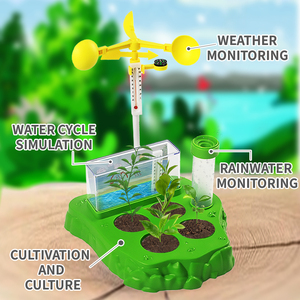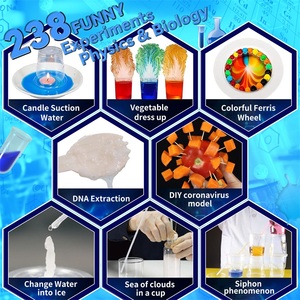
All categories
Featured selections
Trade Assurance
Buyer Central
Help Center
Get the app
Become a supplier

(13860 products available)
















































Science experiments toy come in various types, each designed to provide hands-on learning experiences that promote curiosity and understanding of scientific concepts. Here are some common types:
Chemistry Sets
Basic and advanced chemistry sets are available. The basic sets contain safe, simple experiments for young children. The advanced sets come with more complex experiments for older kids. These sets include reagents, beakers, test tubes, and detailed experiment guides.
Biology Kits
Biology kits focus on subjects like human anatomy, botany, and microbiology. They include items like model organisms, petri dishes, and microscope slides. These kits also contain DNA kits that allow kids to extract DNA from fruits like bananas or strawberries using simple, safe methods.
Physics Toys
These toys demonstrate principles of physics through building kits, circuit sets, and pendulum or gravity-driven toys. They include items like solar-powered cars, wind turbines, and hydraulic lifts. These toys can be used to build simple machines, bridges, and other structures that explore engineering principles.
Environmental Science Kits
Environmental science kits promote awareness of ecology, renewable energy, and sustainability. They include solar-powered gadgets, such as lanterns and chargers. They also include greenhouse kits for growing plants and learning about ecosystems.
Electronics and Robotics Kits
These kits allow children to build and program their gadgets. They range from simple circuit boards with LED lights and buzzers to complex robotics with sensors and programmable features. These kits also include coding toys that teach the basics of programming through interactive games and challenges.
Earth Science Toys
Earth science toys cover geology, meteorology, and astronomy. They include rock and mineral identification kits, weather stations, and telescopes. These toys allow kids to explore the night sky, learn about stars and planets, and conduct earth science experiments.
Steam Toys
These toys integrate science, technology, engineering, arts, and mathematics into cohesive learning experiences. They include kits that blend scientific experiments with creative arts, such as chemistry and painting or electronics and crafting. They also include complete sets that contain multiple disciplines, like building a robot that can paint or a circuit board that triggers art-related functions.
Before buying science experiments toys for sale, consider the age group of the target market. Toys manufactured for younger children are different from those meant for older kids. For instance, they will require different levels of complexity and safety features. Additionally, buyers should get sets that can be used individually or in groups. This gives customers options to select according to their preferences. Also, they should have multiple refill kits available. These will allow the kids to conduct experiments more than once. In this case, the refills should be compatible with the toy sets.
In most cases, science kits require additional materials that are not included in the package. Therefore, business owners should ensure that the toy sets do not need many extra supplies. Also, they should check if the toys have models and instructions that are easy to follow. More importantly, they should ensure that the toys are safe for children to use. They can do this by verifying if they have safety certifications. Finally, business owners should choose sets that are made with durable materials. Such toys can withstand frequent use.
Science experiments toys have a variety of functions, features, and designs that are meant to make learning enjoyable and fascinating. Below are some of them:
Safety should be the primary concern when choosing a toy for younger children. Most toys come with a list of safety precautions to follow. The manufacturer should indicate the age for which the toy is appropriate. This is because some toys may be unsafe for younger children. For example, toys with small parts that can cause choking when ingested by younger children. Toys with sharp edges are also unsafe and should be handled with care. Always read the guidelines before buying a science toy for kids.
Regarding quality, science experiment kits are among the best educational toys because they are built to last. A good quality science experiment kit should come with durable tools that can withstand regular use. The materials used to make the toys should also be sturdy. Kids will handle the toys roughly when playing. Quality science toys also come in well-designed packaging that can be reused to store the toys. The packaging is also eye-catching and appealing to kids. Most science toys come with a well-thought-out manual that is easy to follow. The manual is also printed on quality paper that does not tear easily. In addition, quality toys have customer support and a warranty. This is because the manufacturer is confident in the quality of the toy.
What are the benefits of science experiment toys?
Science experiment toys are beneficial as they help children develop critical thinking and problem-solving skills and understand scientific concepts better. In addition, these toys promote hands-on learning, which is essential for developing a genuine interest in science from an early age.
Can science experiment toys be used in schools?
Yes, science experiment toys can be used in schools for hands-on activities, experiments, and demonstrations. They provide students with practical learning experiences that complement classroom instruction, fostering a deeper understanding of scientific concepts and principles.
Are there eco-friendly options for science experiment toys?
Yes, there are many eco-friendly options for science experiment toys. These toys are made from renewable or recycled materials and are designed to be safe and durable for children. In addition, some toys use solar power or other sustainable energy sources to demonstrate scientific principles.
How do science experiment toys enhance learning?
Science experiment toys enhance learning by providing hands-on, interactive experiences that engage children and make complex scientific concepts more accessible. These toys encourage experimentation, exploration, and discovery, promoting a deeper understanding of science and fostering a love for the subject.